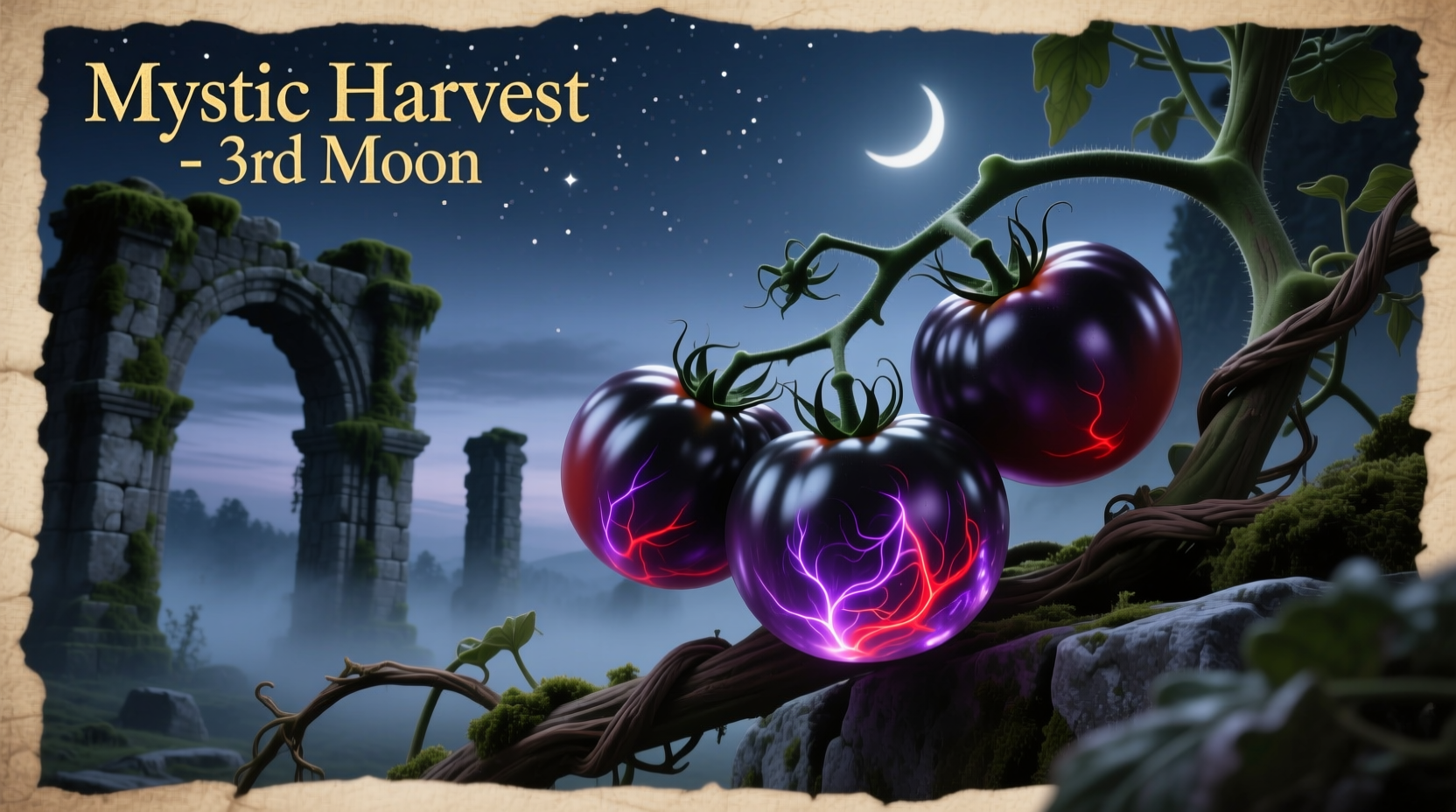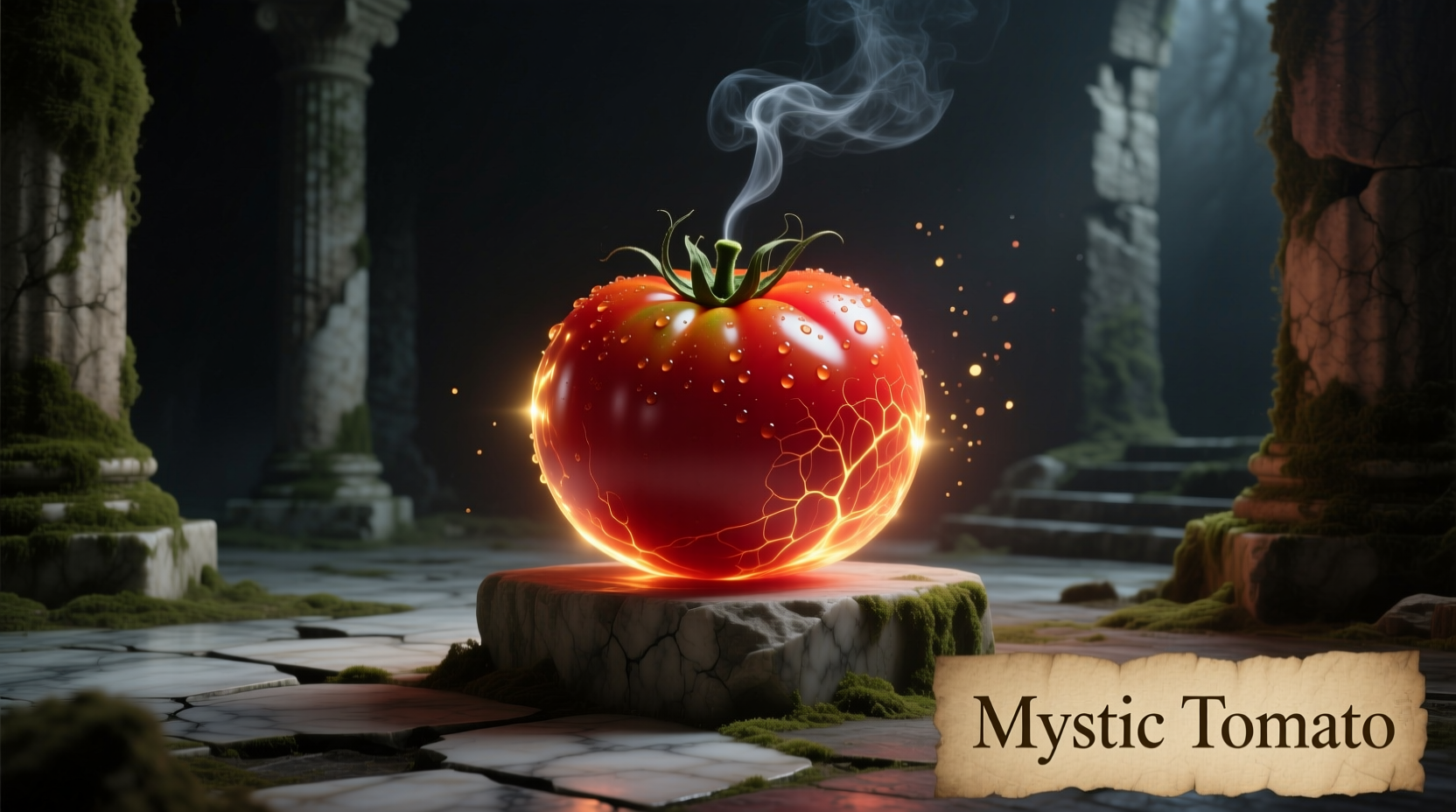When gardeners and food enthusiasts search for "mystic tomato," they're typically seeking information about this distinctive heirloom variety known for its dramatic purple-black coloration and rich nutritional profile. Unlike common red tomatoes, the Mystic tomato (Solanum lycopersicum 'Mystic') belongs to a specialized group of anthocyanin-rich varieties developed through careful breeding. This article provides verified information about its botanical characteristics, cultivation requirements, and culinary applications based on agricultural research and horticultural expertise.
What Exactly Is a Mystic Tomato?
The Mystic tomato isn't a mythical creation but a real, documented heirloom variety developed through selective breeding of anthocyanin-rich tomatoes. This indeterminate variety produces medium-sized (6-8 oz) fruits with deep purple-black skin that retains its dramatic coloration even when fully ripe. Unlike some purple tomato varieties that only show coloration in sunlight-exposed areas, Mystic tomatoes develop uniform dark pigmentation throughout the fruit.
Developed by horticultural researchers building on work with varieties like Indigo Rose, the Mystic tomato represents a significant advancement in anthocyanin-rich tomato breeding. Its distinctive color comes from anthocyanins—powerful antioxidants also found in blueberries and blackberries—that develop in response to sunlight exposure during ripening.

Key Characteristics That Set Mystic Tomatoes Apart
Understanding what makes Mystic tomatoes unique requires examining their specific botanical and sensory properties. These tomatoes offer more than just visual appeal—they represent a convergence of nutritional science and horticultural innovation.
| Characteristic | Mystic Tomato | Standard Red Tomato | Indigo Rose |
|---|---|---|---|
| Color Development | Uniform purple-black throughout | Red when ripe | Purple only on sun-exposed areas |
| Anthocyanin Content | Very high (2-3x Indigo Rose) | Negligible | High |
| Ripening Indicator | Deep purple-black color | Bright red color | Red shoulders indicate ripeness |
| Flavor Profile | Balanced sweet-tart with earthy notes | Classic tomato sweetness | More acidic, less sweet |
From Research to Garden: The Development Timeline
The journey of anthocyanin-rich tomatoes like Mystic represents decades of horticultural research. Understanding this evolution provides context for appreciating what makes Mystic tomatoes special:
- Early 2000s: Oregon State University researchers began crossing wild blue tomato species with cultivated varieties to introduce anthocyanin production
- 2011: Introduction of Indigo Rose, the first commercially available anthocyanin-rich tomato variety
- 2015-2018: Subsequent breeding efforts focused on improving flavor and uniform coloration while maintaining high anthocyanin levels
- 2020: Development of Mystic tomato variety with more consistent purple pigmentation and improved taste profile
- Present: Mystic tomatoes gaining popularity among home gardeners and specialty food producers
According to research published by the USDA Agricultural Research Service, these specialized varieties represent "a significant advancement in functional food development" with potential health benefits associated with increased anthocyanin consumption.
Optimal Growing Conditions for Maximum Flavor and Color
Successfully growing Mystic tomatoes requires understanding their specific environmental needs. Unlike standard varieties, these anthocyanin-rich tomatoes have particular requirements that directly impact their distinctive characteristics.
Climate and Sunlight Requirements
Mystic tomatoes need abundant sunlight to develop their characteristic deep purple coloration. The anthocyanin production that creates their distinctive appearance is directly tied to UV exposure:
- Minimum sunlight: 8-10 hours of direct sun daily for optimal color development
- Ideal temperature range: 70-85°F (21-29°C) during the day, with nighttime temperatures above 55°F (13°C)
- Soil requirements: Well-draining soil with pH between 6.2-6.8, enriched with organic matter
Growers in cooler climates may experience less intense coloration, as anthocyanin production decreases in lower temperatures. The Oregon State University Extension Service notes that "anthocyanin expression in tomatoes is significantly influenced by both light intensity and temperature, with optimal production occurring under warm, sunny conditions."
Planting and Care Guidelines
For best results with Mystic tomatoes, follow these cultivation practices:
- Start seeds indoors 6-8 weeks before last frost date
- Transplant outdoors after soil temperature reaches at least 60°F (15°C)
- Space plants 24-36 inches apart with 4-5 feet between rows
- Provide strong support (cages or trellises) as plants grow 6-8 feet tall
- Water consistently (1-2 inches per week), avoiding wetting foliage
- Apply balanced organic fertilizer when first flowers appear
Culinary Applications: Beyond Visual Appeal
While Mystic tomatoes certainly make a dramatic visual statement, their culinary value extends far beyond appearance. Understanding how to best utilize their unique flavor profile can transform your cooking.
Flavor Profile and Best Culinary Uses
Mystic tomatoes offer a complex flavor profile that differs from standard red varieties:
- Taste characteristics: Balanced sweet-tart flavor with subtle earthy notes and less acidity than many heirloom varieties
- Texture: Firm flesh with fewer seed cavities than standard tomatoes
- Best raw applications: Sliced for sandwiches, caprese salads, or as a colorful garnish
- Best cooked applications: Roasted for sauces, incorporated into salsas, or used in chutneys
Professional chefs note that the anthocyanins in Mystic tomatoes can create interesting color transformations when cooked with acidic ingredients. When making sauces, the purple color may shift toward burgundy or even blue hues depending on pH levels—a phenomenon documented in food science research by the Institute of Food Technologists.
Nutritional Benefits: More Than Just a Pretty Fruit
The distinctive purple color of Mystic tomatoes signals significant nutritional differences compared to standard red varieties. These differences represent more than just visual appeal—they translate to potential health benefits.
Anthocyanins, the pigments responsible for the deep purple color, are powerful antioxidants associated with numerous health benefits. According to research published in the Journal of Agricultural and Food Chemistry, anthocyanin-rich tomatoes like Mystic contain significantly higher levels of these beneficial compounds than standard varieties.
Key nutritional advantages include:
- Higher antioxidant capacity than standard red tomatoes
- Potential cardiovascular health benefits associated with anthocyanin consumption
- Anti-inflammatory properties documented in multiple studies
- Preservation of nutritional benefits even when cooked (unlike some antioxidants)
It's important to note that while these nutritional benefits are promising, Mystic tomatoes should be viewed as part of a balanced diet rather than a standalone health solution. The USDA National Nutrient Database confirms that these varieties maintain the same basic vitamin and mineral profile as other tomatoes while offering additional anthocyanin-related benefits.
Common Challenges and Solutions for Growers
Growing Mystic tomatoes presents some unique challenges compared to standard varieties. Being aware of these potential issues can help ensure gardening success.
Color Development Issues
One of the most common concerns is inadequate color development. If your Mystic tomatoes aren't developing their characteristic deep purple hue:
- Possible cause: Insufficient sunlight exposure
- Solution: Ensure plants receive 8-10 hours of direct sun daily; consider relocating container plants to sunnier spots
- Possible cause: Cool temperatures
- Solution: Use black plastic mulch to warm soil; consider row covers during cool spells
Ripeness Determination
Unlike red tomatoes that change color dramatically when ripe, determining ripeness in Mystic tomatoes requires different indicators:
- Look for deep, uniform purple-black coloration (not just purple)
- Fruit should yield slightly to gentle pressure
- Should detach easily from the vine with a gentle twist
- Avoid waiting for red coloration, which doesn't develop in this variety
Where to Find Authentic Mystic Tomato Seeds
As specialty varieties gain popularity, it's important to source seeds from reputable providers to ensure you're getting the genuine Mystic variety rather than mislabeled alternatives. Look for seed companies that:
- Specialize in heirloom and specialty tomato varieties
- Provide detailed variety descriptions including origin information
- Maintain transparent seed sourcing practices
- Offer germination guarantees
Reputable seed banks and agricultural extension services provide the most reliable sources for authentic Mystic tomato seeds. The Seed Savers Exchange, a nonprofit organization dedicated to preserving heirloom varieties, maintains verified stocks of many specialty tomato varieties including those with high anthocyanin content.











 浙公网安备
33010002000092号
浙公网安备
33010002000092号 浙B2-20120091-4
浙B2-20120091-4